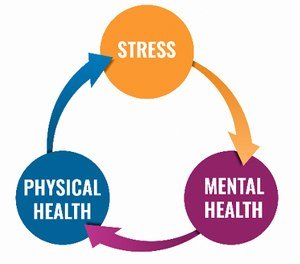Stress, Anxiety and CVD (cardio vascular disease) are strongly linked. If you are interested to find out why, and how to reduce your risk of CVD, do read further. It is something I have experienced, and had a stress induced stroke a few years ago. Thanks to some wonderful support from the NHS, I overcame my challenges and recovered.
I then hired my own stress and anxiety coach to make sure I properly looked after my emotional health, because I didn’t want to experience the same levels of stress and anxiety again, which caused me to have the stroke. This made a massive difference to my life, and I know I help you in the same way too.
This is why I came into coaching and why I’m so passionate about it. To use my training and experience to help you before reaching the critical point I did. If you feel yourself connecting with this material and would like to chat about the support we can offer, please contact me.
Cardiovascular disease (CVD) is a general term for conditions affecting the heart or blood vessels. CVD includes all heart and circulatory diseases. Including coronary heart disease, angina, heart attack, congenital heart disease, hypertension, stroke, and vascular dementia.
Stress is a physiological response to a stressor that threatens an individual’s internal physiological state or psychological well-being. Life is critically dependent on the control of the body’s internal state even when the external environment is constantly changing. This is called homeostasis and when it is threatened, the body undergoes a stress response.
Research shows that acute psychological stress can elicit a cardiovascular response with associated increases in heart rate and blood pressure.
Anxiety is your body’s natural response to stress. It’s a feeling of fear or apprehension about what’s to come. Going to a job interview or giving a speech may cause most people to feel fearful and nervous.
But if your feelings of anxiety are extreme, last for longer than six months, and are interfering with your life, you may have an anxiety disorder.
THE BIGGER PICTURE
Cardiovascular disease is one of the most important health issues of the 21st century and is a leading cause of mortality worldwide.
The most common forms of CVD are stroke and coronary heart disease, which includes myocardial infarction and angina.
Age and genetic factors are risk factors that account for most cases; however, modifiable risk factors such as lifestyle behaviours and psychosocial factors are also well-established contributors.
Psychological and psychiatric factors, in particular, have an important role in the aetiology, development and outcome of cardiovascular disease.

Evidence
Previous studies have shown that depression, stress, and anxiety can result in an increased risk of developing cardiovascular disease.
A recent meta-analysis examining the relationship between PTSD and coronary artery disease (CAD) showed a 46% increased risk of CAD after adjusting for depression.
However, this relationship is bidirectional with significant evidence that there is a high prevalence of mental health disorders in patients with a history of cardiovascular events.
Scientists have also found that people who have heightened activity in the amygdala — the part of the brain commonly linked to stress — are more likely to develop cardiovascular disease.
It contributes to aggravating health risks like hypertension, high cholesterol levels, diabetes, obesity, heart problems, etc. These health issues are categorized as ‘high risk factors’ for a stroke. There is a strong link between stress and physical health.
It has been found in a study that stress apparently raises the risk of a Stroke, or Transient Ischemic Attack (TIA) by 59%. A TIA is a mini stroke caused by a temporary blockage of blood flow to the brain.
Harmful habits
Additionally, stress and anxiety lead to developing harmful habits like smoking, increase in use of alcohol and unhealthy eating habits which are again a well-established risk factors for CVD.
A newly published study in The Lancet would appear to suggest that the amygdala—an almond shaped part of the brain situated in the temporal lobe that is involved in stress and has been previously implicated with post-traumatic stress disorder (PTSD), anxiety and depression—has heightened activity that leads to a greater risk of developing CVD.
Emily Reeve, Senior Cardiac Nurse at the British Heart Foundation, said: “The link between stress and increased risk of developing heart disease has previously focused on the lifestyle habits people take up when they feel stressed such as smoking, drinking too much alcohol and overeating.
“Exploring the brain’s management of stress and discovering why it increases the risk of heart disease will allow us to develop new ways of managing chronic psychological stress.
“This could lead to ensuring that patients who are at risk are routinely screened and that their stress is managed effectively,” she said.
WHAT SHOULD I KNOW?

High levels of stress are associated with worse medical outcomes. Multiple major studies suggesting stress management should be added to current cardiovascular rehabilitation programs.
Psychosocial interventions such as cognitive-behavioural and stress management can improve stress-coping skills, quality of life and decrease negative moods. They have favourable influences on morbidity, mortality, and markers of CVD progression.
The study of over 6,700 people aged between 45 and 84 years, reported in the American Heart Association’s journal Stroke, compared the rates of full and mini-stroke between people of different psychological profiles rated via questionnaire.
Compared with people who had healthy psychological scores, those with the poorest scores showed the following percentage increases in their likelihood of suffering a stroke or transient ischemic attack (TIA):
- 86% for a high score on depressive symptoms
- 59% for the highest ratings of chronic stress.
On the effect of feelings of hostility – “which is a negative way of viewing the world” and was assessed by the person’s “cynical expectations of other people’s motives” – this resulted in a doubling of the risk versus people who did not score highly on this profile. Feelings of anger, however, had no effect.
Dr Susan Everson-Rose, lead author and associate professor of medicine at the University of Minnesota in Minneapolis, says:
“There’s such a focus on traditional risk factors – cholesterol levels, blood pressure, smoking and so forth. These are all very important, but studies like this one show that psychological characteristics are equally important.”
The chronic stress was measured using ratings for five different domains of the participants’ lives:
- Personal health problems
- Health problems of people close to them
- Job or ability to work
- Relationships
- Finances.
Evidence data
The data for this analysis came from a study across six US sites known as the Multi-Ethnic Study of Atherosclerosis.
The 6,749 participants were from a mix of ethnic backgrounds across Baltimore, MD, Chicago, IL, Forsyth County, NC, Los Angeles, CA, New York City, NY, and Saint Paul, MN.
The almost equal numbers of men and women showed no evidence of cardiovascular disease at the start of the research in the early 2000s.
During the first 2 years of the recruitment, the baseline ratings of depression and chronic stress were assessed. The subjects were monitored for an additional 8.5 to 11 years.
During the study, 147 strokes and 48 TIAs occurred. The researchers did a statistical analysis at the end to compare the rates of disease between different levels of psychological health.
The following lifestyle factors taken into account were:
- Smoking
- Physical activity
- Alcohol consumption
- Body mass index
- Blood pressure.
Independent of these factors, if depression, stress, and anxiety can be assumed to have a direct causal effect on stroke, then, the authors offer only theoretical ideas about what the biological link might be.
“Stress and negative emotions activate the hypothalamic-pituitary-adrenal axis,” they write, and this activation of the brain’s stress centre influences blood clotting, among a number of other effects listed in the paper.
The study’s conclusion reads: “Our study demonstrates associations between excess stroke/TIA risk and depressive symptoms, chronic stress, and hostility, which were not explained by traditional stroke risk factors, inflammatory markers, or subclinical atherosclerosis.
CONCLUSION
These studies show a strong relationship between stress, the increased activity of the major emotional stress networks in the brain, and a greater risk of developing cardiovascular disease.
“Better understanding of important, potentially modifiable stroke risk factors, including stress and negative emotions, is needed given the aging population and increasing burden of CVD.”
What next
So if these studies show the causal link between stress, anxiety and CVD is there anything you can do to reduce the risks? The answer is YES ABSOLUTELY YOU CAN. There are a number of strategies you can use to reduce your stress and anxiety, and thus reduce the risk of a CVD incident.

Exercise
The physical benefits of exercise have long been established, and physicians always encourage staying physically active.
Exercise is also considered vital for maintaining mental fitness, and it can reduce stress and anxiety. Studies show that it is highly effective at reducing fatigue, improving alertness and concentration, and at enhancing overall cognitive function. This can be especially helpful when stress has depleted your energy or ability to concentrate.
When stress affects the brain, with its many nerve connections, the rest of the body feels the impact as well. Or, if your body feels better, so does your mind. Exercise and other physical activity produce endorphins — chemicals in the brain that act as natural painkillers — and also improve the ability to sleep, which in turn reduces stress.
Scientists have found that regular participation in aerobic exercise has been shown to decrease overall levels of tension. They also elevate and stabilize mood, improve sleep, and improve self-esteem. About five minutes of aerobic exercise can begin to stimulate anti-anxiety effects.
Equally as beneficial forms of exercise are stress reducing activities such as yoga, mindfulness practice and Qigong. (link to another blog post on the benefits of qigong for stress and anxiety)
Diet
When we’re stressed or anxious, our dietary habits can radically alter too. We can either comfort eat or go the complete opposite and hardly eat because we’re too stressed. Nutrition is an important factor in managing our stress. If our body is healthy, our mind is healthier too. The correct diet allows our body to cope far better with stress than if we’re eating poorly. For years, research into connections between diet and CVD focused on individual nutrients like cholesterol (and foods high in dietary cholesterol, like eggs), types of fats, and specific vitamins and minerals. This work has been revealing, but it has also generated some dead ends, along with myths and confusion about what constitutes a heart-healthy diet. That’s because people eat food, not nutrients.
- The best diet for preventing heart disease is one that is full of fruits and vegetables, whole grains, nuts, fish, poultry, and vegetable oils. Includes alcohol in moderation, if at all. Go easy on red and processed meats, refined carbohydrates. Foods and beverages with added sugar, sodium, and foods with trans-fat are also unhealthy.
- People with diets consistent with this dietary pattern had a 31% lower risk of heart disease, a 33% lower risk of diabetes, and a 20% lower risk of stroke.
Weight and waistline
The following information is linked to the previous section on diet. It is also linked to overindulgence in the wrong type of foods that we often use when we’re stressed or anxious.
Being overweight can lead to fatty material building up in your arteries (the blood vessels that carry blood to your organs). If the arteries that carry blood to your heart get damaged and clogged, it can lead to a heart attack. If this happens in the arteries that carry blood to your brain, it can lead to a stroke or vascular dementia.
Body fat and body shape
Everyone needs some body fat to stay healthy. But too much, particularly around the waist, puts your health at risk.
We have different types of fat in the body.
Many people tend to worry about the fat they can feel, the one that sits directly under their skin. This is called subcutaneous fat. But it’s visceral fat, the fat that surrounds our internal organs such as our heart and liver, that is the bigger health risk.
Visceral fat affects how your hormones work and can:
- raise your blood cholesterol
- increase your blood pressure
- increase your risk of developing Type 2 Diabetes.
All of these risk factors are closely linked with heart and circulatory diseases.
Carrying weight around your middle can make it harder for your body to use a hormone called insulin, which controls your blood glucose (sugar) levels. This can lead to Type 2 diabetes. Having high levels of glucose in your bloodstream damages your arteries and increases your risk of heart and circulatory diseases.
People who are ‘apple’ shaped (carry excess weight around their middle) are at higher risk than those who are ‘pear’ shaped (carry weight around their hips, thighs, and bottom) because the fat sits around their organs.
Apple-shaped body with visceral fat around the organs (left) and pear-shaped body with subcutaneous fat under the skin (right).
How do I know if I’m overweight or obese?
There are two measurements commonly used to assess whether you’re overweight – Body Mass Index (BMI) and waist circumference.
Measuring your BMI
The first step to calculating your BMI is to measure your height and weight. Your GP or practice nurse can do this for you if you can’t do this at home.
Your BMI score will place you into one of four categories: underweight, healthy, overweight, or obese.
As BMI doesn’t take muscle mass into account, you may find yourself in the overweight or obese category if you’re muscular.
Your ethnicity can also affect your health risk. For example, adults of South Asian and African Caribbean origin may have a higher risk of health problems at BMI scores below 25.
This is why it’s important to use other measurements to assess your health risk, like waist measurement.
Waist measurement
You can measure your waist to see whether you’re carrying too much fat around your middle. A larger waist measurement is often a sign that you have too much visceral fat.
It’s important to note that your waist measurement will not be the same as the measurement you use when shopping for your trousers.
To measure your waist, you’ll need a tape measure. You should place it halfway between the bottom of your ribs and top of your hips. Hold the tape measure firmly just above your belly button to take the measurement.
Use the BHF waist measurement tool to check whether your waist measurement is putting your health at risk.
The recommended waist measurements are:
- below 37 inches (94cm) for men
- below 31.5 inches (80cm) for women.
Adults of South Asian origin are at very high risk of health problems if their waist measurements are higher than the recommended measurements.
(information obtained from the British Heart Foundation)
Not smoking
One of the best things you can do for your health is to not use tobacco in any form. Tobacco use is a hard-to-break habit that can slow you down, make you sick, and shorten your life. One way it does this is by contributing to CVD. Increase in tobacco use has been shown in many studies for people who are showing increased levels of stress and anxiety. We reach for a cigarette if we’re stressed to ‘calm us down’. In fact it has the opposite effect and elevates our blood pressure.
In fact, researchers examining the relationship between cigarette smoking and smoking cessation on mortality during a decades-long perspective study of over 100,000 women. It found that approximately 64% of deaths among current smokers and 28% of deaths among former smokers were attributable to cigarette smoking.
- This study also reported that much of the excess risk due to smoking may be drastically lowered after quitting. Additionally, the excess risk for all-cause mortality—that is, death from any cause—decreases to the level of a “never-smoker” 20 years after quitting.
Reduce the psychological symptoms of stress
Link to a previous blog post on specific ways to manage your stress.
Putting it all together
You can help prevent heart disease by doing five key things and making them into habits:
Reduce your stress and anxiety now.
Don’t smoke (or quit if you do)
Maintain a healthy weight
Exercise; be active
Follow a healthy diet
Strong studies make it possible to link reductions in risk to these habits. Following a healthy lifestyle may prevent over 50% of ischemic strokes. 80% of sudden cardiac deaths and 72% of premature deaths related to heart disease. In other words, a healthy lifestyle is a good investment in a longer, healthier life.
If you would like any further advice on the topics discussed above and want to reduce your stress and anxiety to live a healthier life, please contact me for a chat on how you can do this. This is something I have experienced myself and I know I can help you too.






